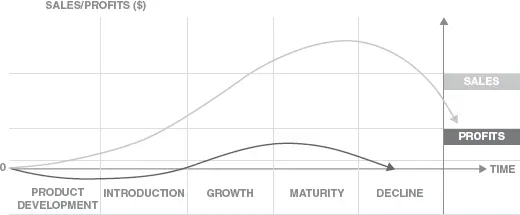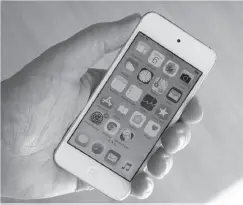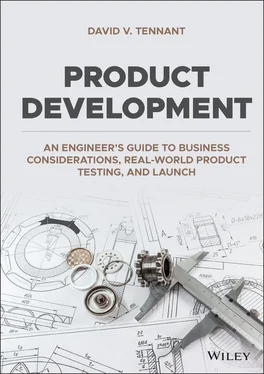David V. Tennant - Product Development
Здесь есть возможность читать онлайн «David V. Tennant - Product Development» — ознакомительный отрывок электронной книги совершенно бесплатно, а после прочтения отрывка купить полную версию. В некоторых случаях можно слушать аудио, скачать через торрент в формате fb2 и присутствует краткое содержание. Жанр: unrecognised, на английском языке. Описание произведения, (предисловие) а так же отзывы посетителей доступны на портале библиотеки ЛибКат.
- Название:Product Development
- Автор:
- Жанр:
- Год:неизвестен
- ISBN:нет данных
- Рейтинг книги:5 / 5. Голосов: 1
-
Избранное:Добавить в избранное
- Отзывы:
-
Ваша оценка:
- 100
- 1
- 2
- 3
- 4
- 5
Product Development: краткое содержание, описание и аннотация
Предлагаем к чтению аннотацию, описание, краткое содержание или предисловие (зависит от того, что написал сам автор книги «Product Development»). Если вы не нашли необходимую информацию о книге — напишите в комментариях, мы постараемся отыскать её.
An insightful development roadmap to help engineers and businesspeople successfully bring a product to market Product Development: An Engineer’s Guide to Business Considerations, Real-World Product Testing, and Launch,
Product Development
Product Development
Product Development — читать онлайн ознакомительный отрывок
Ниже представлен текст книги, разбитый по страницам. Система сохранения места последней прочитанной страницы, позволяет с удобством читать онлайн бесплатно книгу «Product Development», без необходимости каждый раз заново искать на чём Вы остановились. Поставьте закладку, и сможете в любой момент перейти на страницу, на которой закончили чтение.
Интервал:
Закладка:
All products exhibit a lifecycle. Figure 2.2 shows a typical product lifecycle. Notes about the product lifecycle:

Figure 2.2 Product Lifecycle. Lumen Learning, viewed 15 February 2021. https://courses.lumenlearning.com/clinton-marketing/chapter/reading-stages-of-the-product-life-cycle/.
Development stage –
Product/project is funded, and design of prototype starts
Prototype put through testing, and data collection
Review of data; evaluation of results
Changes in design and more testing
Final product handed over to manufacturing or external group for production
Introduction stage –
The product is new to the market and demand will increase with time
The cost per unit (or customer) is high
Few if any competitors
Sales are low and the product may be a money loser during the introductory stage
Growth stage –
Sales and revenue increase; the product is taking off in the marketplace
Competitors are becoming aware of your activity and may start to develop a competing product
Cost per unit (or customer) begins to decline
Profit margins increase
Maturity stage –
Sales, revenues, and profits peak
Cost per unit (or customer) is at the lowest point
Competitors are now actively nipping at your heels
Decline stage –
Sales and revenue decline, leading to a decline in profit margin
Cost per unit (or customer) is still low, but may rise with fewer units sold
Competitors start to fall away. A few will remain, but with a reduced market there are less sales and therefore profits to share. The product may become stable with steady sales but will not see the heavy growth or revenues seen in the growth stage.
Example of Product Displacement
In the late 1990s, Nokia produced cell phones that were widely used by the public – worldwide. Nokia, headquartered in Helsinki, Finland appeared to have a dominant position in the market. The Nokia 3210 (Figure 2.3) was compact, had many features, was very rugged and ergonomically comfortable to hold and operate. As a result, around 150-million units were sold. But, based on the previous discussion, we know that dominance in the marketplace can be upset by newer technology or lower-priced models with the same features. Along came the Apple 2G (Figure 2.4), which gained immediate acceptance by the public. The iPhone 2G had numerous apps, used a color touchscreen, and could connect with the internet in addition to all the things that the Nokia did (texting, photos, etc.).

Figure 2.3 Nokia Phone. Isaac Smith / Unsplash

Figure 2.4 Apple iPhone. Michal Weidemann / Unsplash
Some general characteristics of products include:
Features – nice displays (computer screens), user friendly operation (electric vehicles), the wow factor (new and innovative, nobody does this – Wow!), and a variety of models to fit various budgets (low, middle, and high-end). The Apple iPhone definitely had the “wow” factor. Thirty years later, there are now competitors to the Apple iPhone.
Specifications – a technical description or requirement of what the product can do. For example, if our new product is an electric motor for electric vehicles: the materials used to make the product (steel, stainless steel, etc.); the number of motor brushes and material; outputs –horsepower, torque; the range of temperatures for optimum operation, etc. If you pick up any standard-powered car brochure, specifications usually include items such as horsepower, torque, engine displacement, fuel requirements, etc. Specifications may sometimes be spelled out by the customer for special orders or custom applications.
Warranties and guarantees – will your company stand behind its new product?
Service Centers – what if I need service for my new scanner/printer? Where do I go? Is there a center nearby? Note: a service center can generate additional after-sale profits: think of automobile dealers and their service center networks.
What Marketing Cannot Do
The marketing group cannot guarantee that your product will be successful. Nor can marketing predict how many customers will buy your product, nor say with confidence how much revenue or profits will be gained. But spreadsheet models will be created that have various projections and sensitivity analysis. Marketing in today’s world is very dependent on data analytics which helps clarify the target market and product acceptance. Table 2.2shows an example of price, margin, and volume sensitivity analysis.
Table 2.2 Price and Margin Sensitivity for Solar Power Device.
| Sale Price | ||||
|---|---|---|---|---|
| 10% of 16.9 million | Price Sensitivity | TTL Revenue | Margin | Margin % |
| 1,960,000 | $ 50.00 | $ 98,000,000.00 | $ 24,500,000.00 | 25% |
| 1,960,000 | $ 45.00 | $ 88,200,000.00 | $ 19,404,000.00 | 22% |
| 1,960,000 | $ 40.00 | $ 78,400,000.00 | $ 15,680,000.00 | 20% |
| 1,960,000 | $ 35.00 | $ 68,600,000.00 | $ 11,662,000.00 | 17% |
Table by David Tennant
Discussion Case 2.2 (Refer to Table 2.2)
Your marketing team has performed the following analysis. The new product is a portable external battery device that can power your laptop computer for up to one full day. The unit can be charged using regular home electric current or using the sun (solar power) in about one hour. This device is smaller than competing devices (a little larger than a flash drive) and more versatile. The target market is college students, nationwide. The new product has been designed to be trendy, easy to use, and reasonably priced. There are approximately 19.6 million college students in the USA.
We will assume that 10% of the total number of students will purchase the product and that the average cost will be $50. Note that the margin (profit) declines per unit as price declines. Discussion questions for Case 2.1:
1 What are the advantages and disadvantages of this kind of modeling?
2 Why do you think margins per unit decline as the price drops?
3 Looking at the sale prices compared to margins (%), is $50 the best price? How do you know students will pay this amount for your product?
4 If 10% of students purchase your product the best-case scenario shows $98 million in revenue and profits of $24.5 million. The worst case is a profit margin of $11.662 million. In your opinion, are these numbers realistic?
5 Do you think you will have competitors prior to reaching the maturity stage?
6 Is this type of analysis realistic?
7 What role would the engineering or R&D group play in this evaluation?
8 The chart above shows gross revenues and net profits. There is no mention of the cost of the product. What are some of the costs that would be involved? Can you determine from the chart above the total “costs” of the product?
The 2 ndP – Promotion
The promotion of your new product is critical. And this is where marketing generally gets confused with sales. Promotion deals with how to get your product and its message out to the public, ideally in front of your competitors. Promotion is where marketing creates value to customers, or even the perception of value.
Читать дальшеИнтервал:
Закладка:
Похожие книги на «Product Development»
Представляем Вашему вниманию похожие книги на «Product Development» списком для выбора. Мы отобрали схожую по названию и смыслу литературу в надежде предоставить читателям больше вариантов отыскать новые, интересные, ещё непрочитанные произведения.
Обсуждение, отзывы о книге «Product Development» и просто собственные мнения читателей. Оставьте ваши комментарии, напишите, что Вы думаете о произведении, его смысле или главных героях. Укажите что конкретно понравилось, а что нет, и почему Вы так считаете.











